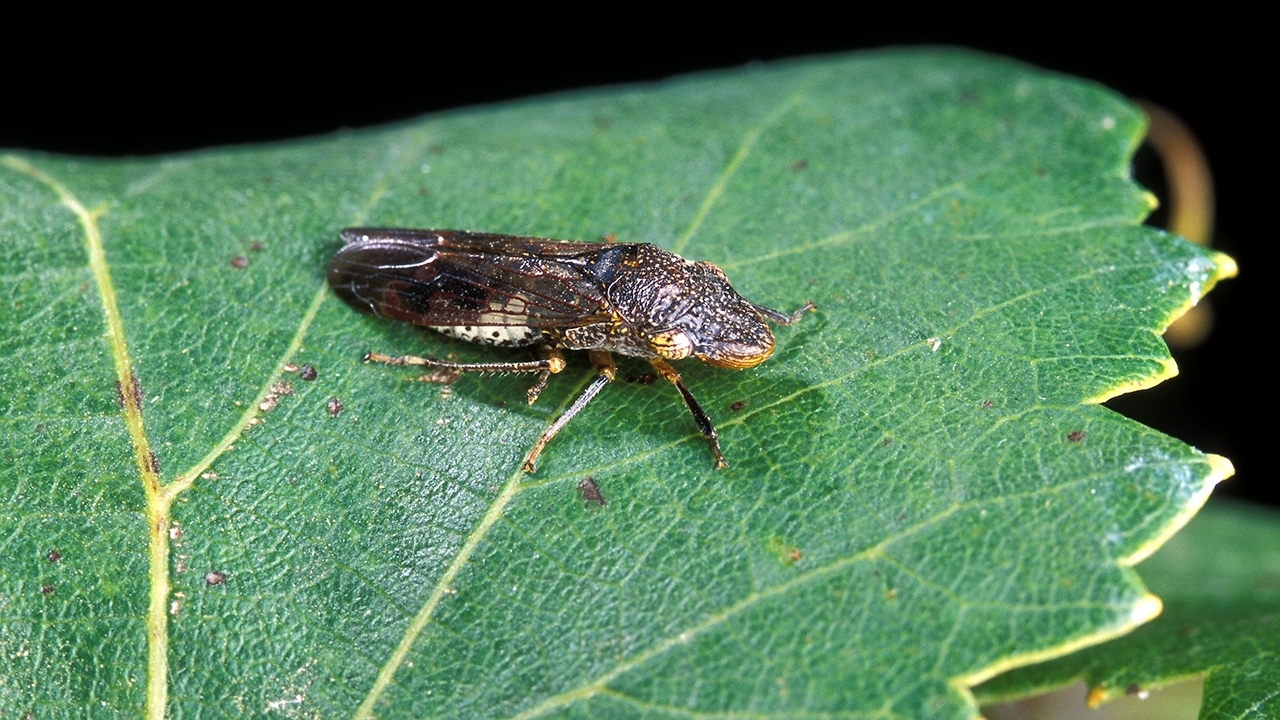Glassy-Winged Sharpshooter

Glassy-winged sharpshooter is a leafhopper that is native to the southeastern United States. In the 1990s, it became established in California and threatened the grape industry. When sharpshooters feed on grapevines, they spread a harmful bacteria (Xylella fastidiosa). The bacteria cause Pierce's disease, which impacts grape quality and fruit production. Pierce's disease eventually kills the grapevines, especially in temperate climates.
The glassy-winged sharpshooter thrives in ample sunshine and a mild climate. It also spreads Pierce's disease more effectively than other insects because of its biology, feeding activity, and mobility. This deadly combination is a threat to California grapes, which account for about 94 percent of U.S. grape production.
Glassy-winged sharpshooters are large leafhoppers—about one-half inch long. They have a flat triangular shaped head and large eyes. They spread Pierce's disease when they feed on grapevine. Here's what to look for:
- Immature branches
- New branches don't mature properly. Patches of green, or "green islands," surround mature brown bark. Symptoms gradually spread along the immature branches, from the point of infection toward the tip of the plant, and more slowly towards the base. Tips of new branches and roots may start to deteriorate.
- Discolored leaves
- Along the edges, leaves turn slightly yellow or red and eventually dry or die, leaving circle patterns.
- Shriveled and clustered grapes
- Grapes wilt and dry, or "raisin up," before harvest time. By mid-season, some or all fruit clusters on the infected branches may wilt and dry.
- Matchsticking
- Leaves fall prematurely. However, their leafstalks remain, making them look like green matchsticks.
Note: You may not see all four symptoms in diseased grapevines.
To prevent further spread of the glassy-winged sharpshooter and the bacteria it spreads, growers and others should:
- Rouge/remove infected vines
- Ensure plants, especially nursery stock and citrus, are inspected before they are moved from southern California to another part of the State
There is no treatment for Pierce's disease. Once a grapevine shows signs of disease, it must be removed and destroyed to stop the spread. This is critical to help reduce infection rates.
The probability of vines recovering from Pierce's disease depends on several factors, including:
- When the plant was infected
- Temperatures in the winter following infection
- The variety's tolerance to Pierce's disease
Recovery is unlikely if disease symptoms are present in the same growing season the plants were infected. This is especially true for varieties that are very susceptible to Pierce's disease, such as Santa Barbara Pinot Noir or Chardonnay.
Report Plant Pests and Diseases
Have you seen this pest or signs of pest damage? Immediately report your findings.
Find your State plant regulatory official
Find your State plant health director
Controlling the Glassy-Winged Sharpshooter
The glassy-winged sharpshooter program has successfully limited the spread of the pest in California's grape-growing regions.
Maps
Since 2000, APHIS has supported the Pierce's Disease Control Program. This program is a cooperative effort between APHIS, the California Department of Food and Agriculture (CDFA), the California Agricultural Commissioners, the University of California, and other stakeholders. It has five components:
- Pest containment
- Survey and detection
- Rapid response
- Outreach
- Research
Pest containment activities include nursery and citrus regulations, area-wide management programs, treatments on affected acreage, and biological control releases.

